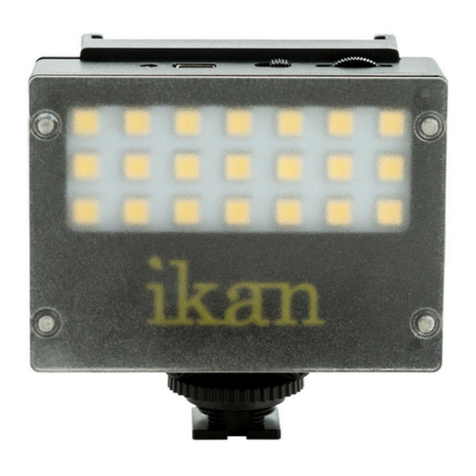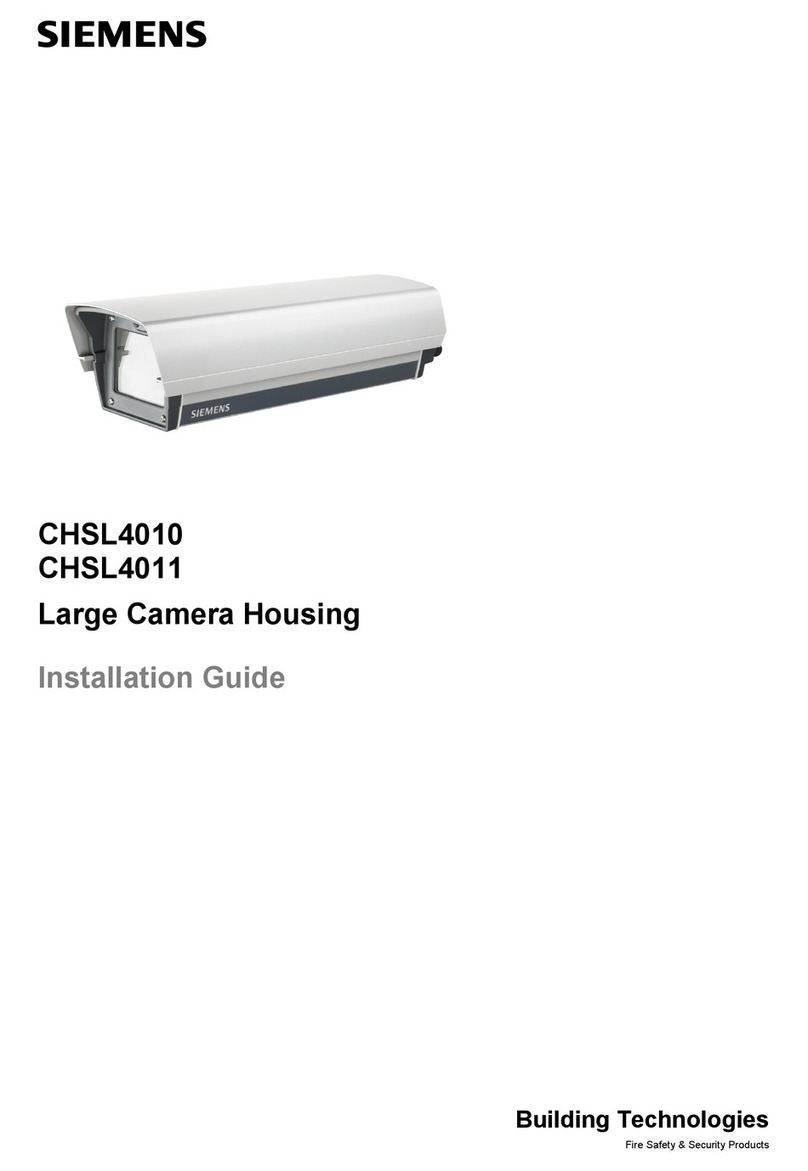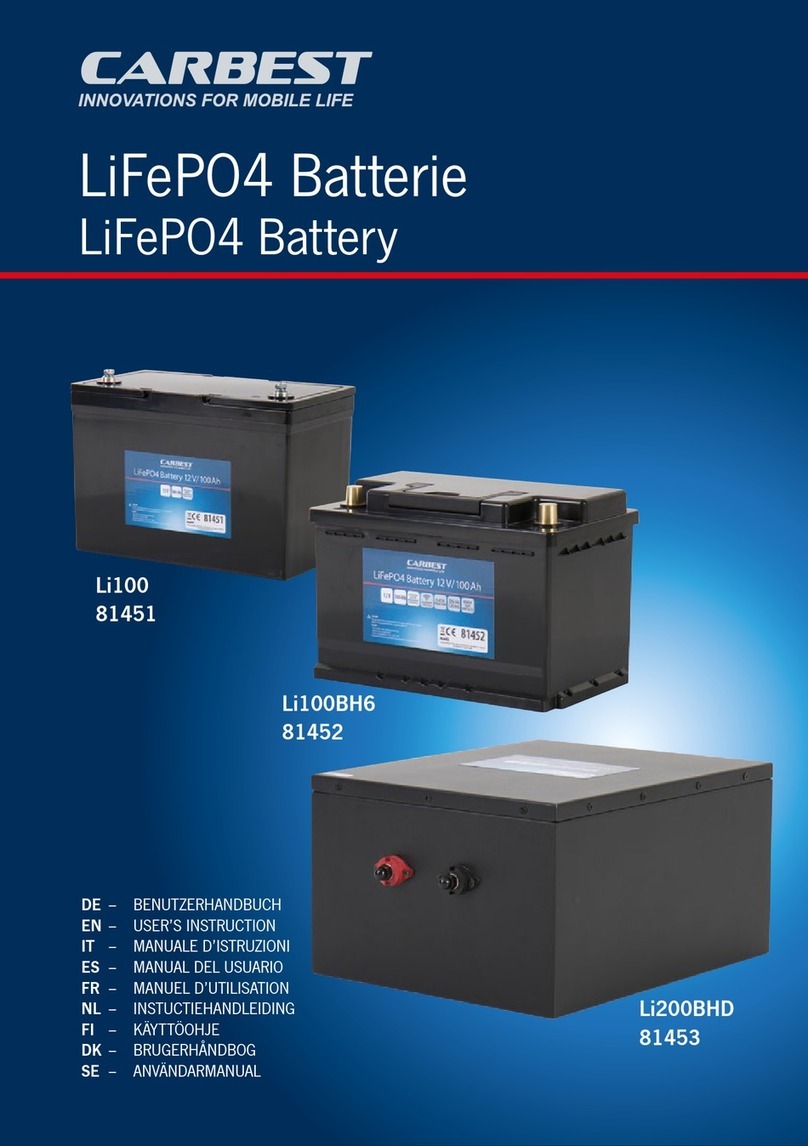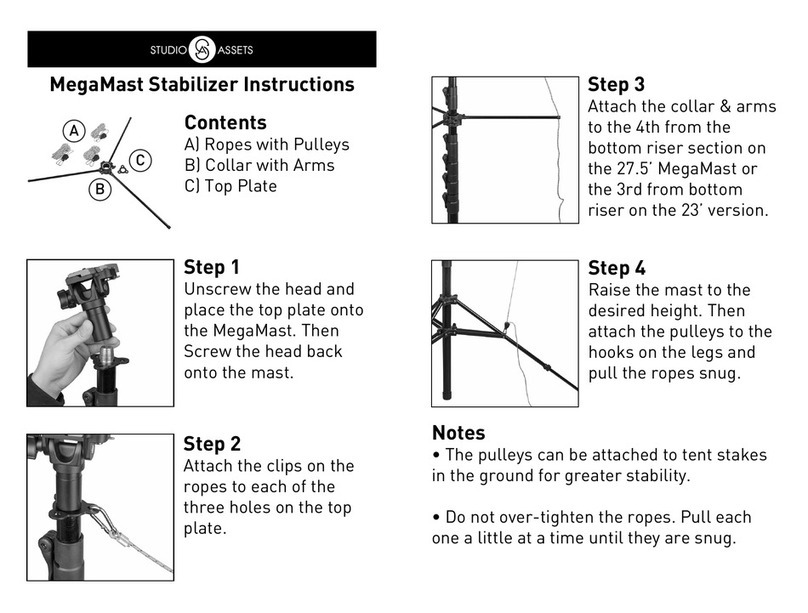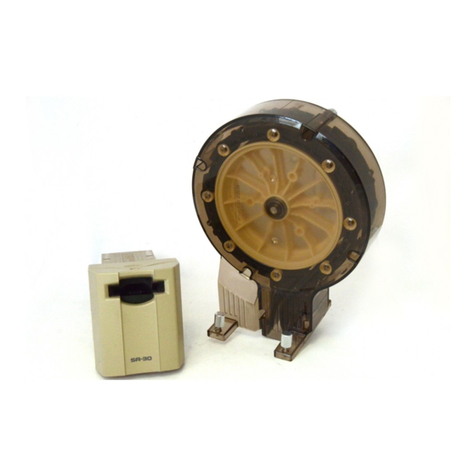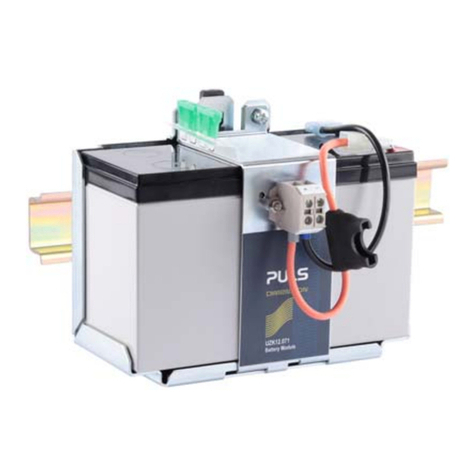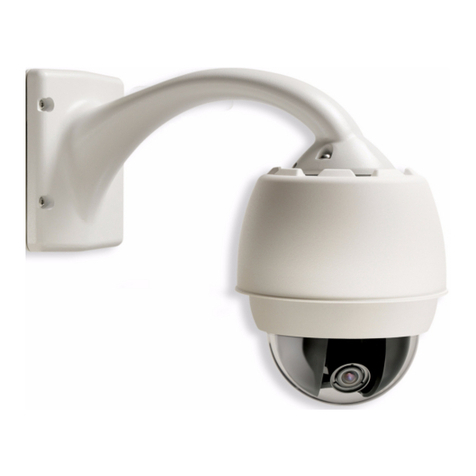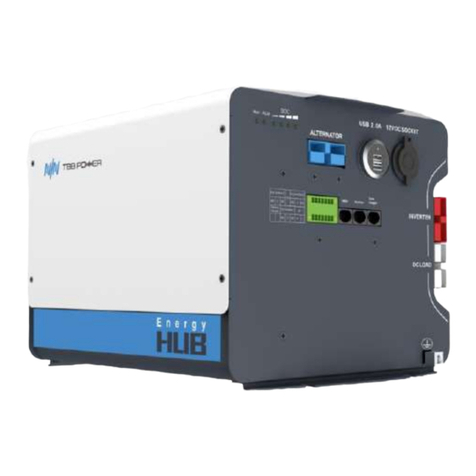Forster X Series User manual

F12-020X
F12-040X
F12-060X
F12-080X
F12-100X
F12-120X
F12-200X
F12-240X
F12-300X
F24-050X
F24-100X
F24-120X
F36-100X
F48-050X
F48-050XC
F48-050XM
WWW.FORSTER-BATTERIES.DE
INNOVATION.
ENGINEERING.
SOLUTION.
LITHIUM X-SERIE PREMIUM
OPERATING INSTRUCTIONS

OPERATING INSTRUCTIONS
WWW.FORSTER-BATTERIES.DE2
F12-020X
F12-040X
F12-060X
F12-080X
F12-100X
F12-120X
F12-200X
F12-240X

WWW.FORSTER-BATTERIES.DE 3
F12-300X
F24-050X
F24-100X
F24-120X
F36-100X
F48-050X
F48-050XC
F48-050XM

WWW.FORSTER-BATTERIES.DE4
TECHNICAL SPECIFICATIONS
DATA / ORDER NO.: F12-020X F12-040X F12-060X F12-080X F12-100X F12-120X F12-200X F12-240X F12-300X F24-050X F24-100X F24-120X F36-100X F48-050X F48-050XC F48-050XM
EAN 4251847300013 4251847300020 4251847300037 4251847300044 4251847300051 4251847300075 4251847300099 4251847300105 4251847301126 4251847300112 4251847300129 4251847300136 4251847300143 4251847300150 4251847301607 4251847301614
Capacity 20Ah 40Ah 60Ah 80Ah 100Ah 120Ah 200Ah 240Ah 300Ah 50 Ah 100Ah 120Ah 100Ah 50Ah 50Ah 50Ah
Replaces lead-gel-AGM battery 12V/40Ah 80Ah 120Ah 160Ah 200Ah 240Ah 400Ah 480Ah 600Ah 100Ah 200Ah 240Ah 200Ah 100Ah 100Ah 100Ah
Nominal voltage 12.8V 12.8V 12.8V 12.8V 12.8V 12.8V 12.8V 12.8V 12.8V 25.6V 25.6V 25.6V 38.4V 51.2V 51.2V 51.2V
Energy content 256Wh 512Wh 768Wh 1024Wh 1280Wh 1536Wh 2560Wh 3072Wh 3840Wh 1280Wh 2560Wh 3072Wh 3840Wh 2560Wh 2560Wh 2560Wh
Operating voltage 10.5V - 14.6V 10.5V - 14.6V 21.0V - 29.2V 31.5V - 43.8V 42.0V - 58.4V
Application in shunt circuit yes, any number of the same type can be operated parallel! yes, any number of the same type can be operated parallel!
Application in serial connection yes, 24V, 36V and a maximum of 48V can be operated serially! yes, max. 48V no
Cell technology Lithium LiFePO4 Lithium LiFePO4
Cell type BPC Big Prismatic Power high-performance cells – GradeAA BPC Big Prismatic Power high-performance cells – GradeAA
Charging programmes CCCV / IU / IUoU / lead-acid CCCV / IU / IUoU / lead-acid
End-of-charge voltage 14.2V - 14.6V 14.2V - 14.6V 28.4 - 29.2V 42.6 - 43.8V 56.8 - 58.4V
Trickle charge 13.3 - 13.8V 13.3 - 13.8V 26.6 - 27.6V 39.9 - 41.4 V 53.2 - 55.2V
Maximum charging current 20A 40A 60A 80A 100A 120A 200A 200A 200A 50A 100A 120A 100A 50A 50A 50A
Recommended charging current 10A 20A 30A 40A 50A 60A 100A 100A 150A 25A 50A 60A 50A 25A 25A 25A
Max. discharge current / 5 sec. 400A 400A 400A 400A 400A 400A 400A 400A 400A 200A 200A 200A 200A 200A 200A 200A
Continuous discharge current 200A 200A 200A 200A 200A 200A 200A 200A 200A 100A 100A 100A 100A 100A 100A 100A
Battery shutdown 10.5V 10.5V 10.5V 10.5V 10.5V 10.5V 10.5V 10.5V 10.5V 21.0V 21.0V 21.0V 31.5V 42.0V 42.0V 42.0V
BMS Battery Management System integrated integrated integrated integrated integrated integrated integrated integrated integrated integrated integrated integrated integrated integrated integrated integrated
Remote monitoring optional (at X) optionally available with 500A Bluetooth measuring shunt and free app optionally available with 500A Bluetooth measuring shunt and free app
Remote measuring shunt integrated F12-020XB F12-040XB F12-060XB F12-080XB F12-100XB F12-120XB F12-200XB F12-240XB F12-300XB F24-050XB F24-100XB F24-120XB F36-100XB F48-050XB n/a n/a
Protection Class IP67 IP67 IP67 IP67 IP67 IP67 IP67 IP67 IP67 IP67 IP67 IP67 IP67 IP67 IP67 IP54
Cycles / longevity at 50% DoD >6000 >6000 >6000 >6000 >8000 >6000 >6000 >6000 >8000 >6000 >6000 >6000 >6000 >6000 >6000 >6000
Cycles / longevity at 80% DoD >4000 >4000 >4000 >4000 >6000 >4000 >4000 >4000 >6000 >4000 >4000 >4000 >4000 >4000 >4000 >4000
Cycles / longevity at 90% DoD >3000 >3000 >3000 >3000 >5000 >3000 >3000 >3000 >5000 >3000 >3000 >3000 >3000 >3000 >3000 >3000
Charging temperature 0°C to +60°C / below 0°C the charging current is automatically reduced through "Cell Frost Control" as part of the BMS 0°C to +60°C / below 0°C the charging current is automatically reduced through "Cell Frost Control" as part of the BMS
Discharge temperature -20°C to +60°C -20°C to +60°C
Recommended storage temperature -10°C to +30°C -10°C to +30°C
Storage 80 - 100% charged / when not in use, load battery every 6 months 80 - 100% charged / when not in use, load battery every 6 months
Self-discharge 1-2% / month 1-2% / month
Connection M8 internal thread M8 internal thread
Arrangement of positive pole front left
front right
front left
front right
Preparation of shunt mounting n/a n/a n/a n/a n/a n/a n/a n/a n/a n/a n/a n/a n/a n/a n/a n/a
Emergency stop button mounted n/a n/a n/a n/a n/a n/a n/a n/a n/a n/a n/a n/a n/a n/a n/a n/a
Length 260mm 260mm 260mm 260mm 330mm 405mm 405mm 520mm 520mm 330mm 405mm 520mm 520mm 520mm 520mm 465mm
Width 170mm 170mm 170mm 170mm 170mm 175mm 175mm 268mm 268mm 170mm 175mm 268mm 268mm 268mm 268mm 345mm
Height 220mm 220mm 220mm 220mm 220mm 235mm 235mm 220mm 220mm 220mm 235mm 220mm 220mm 220mm 220mm 195mm
Mounting position any, standing, lying, on the side, upright, headfirst any, standing, lying, on the side, upright, headfirst
Weight 3.9kg 6.1kg 8.3kg 9.9kg 10.9kg 14.5kg 21.0kg 28.0kg 31.5kg 11.0kg 16.0kg 28.0kg 30.0kg 28.0kg 28.0kg 29.0kg
Warranty 5 years 5 years 5 years 5 years 5 years 5 years 5 years 5 years 5 years 5 years 5 years 5 years 5 years 5 years 5 years 5 years
Certification UN38.3 | MSDS | CE | RoHS UN38.3 | MSDS | CE | RoHS

WWW.FORSTER-BATTERIES.DE 5
DATA / ORDER NO.: F12-020X F12-040X F12-060X F12-080X F12-100X F12-120X F12-200X F12-240X F12-300X F24-050X F24-100X F24-120X F36-100X F48-050X F48-050XC F48-050XM
EAN 4251847300013 4251847300020 4251847300037 4251847300044 4251847300051 4251847300075 4251847300099 4251847300105 4251847301126 4251847300112 4251847300129 4251847300136 4251847300143 4251847300150 4251847301607 4251847301614
Capacity 20Ah 40Ah 60Ah 80Ah 100Ah 120Ah 200Ah 240Ah 300Ah 50 Ah 100Ah 120Ah 100Ah 50Ah 50Ah 50Ah
Replaces lead-gel-AGM battery 12V/40Ah 80Ah 120Ah 160Ah 200Ah 240Ah 400Ah 480Ah 600Ah 100Ah 200Ah 240Ah 200Ah 100Ah 100Ah 100Ah
Nominal voltage 12.8V 12.8V 12.8V 12.8V 12.8V 12.8V 12.8V 12.8V 12.8V 25.6V 25.6V 25.6V 38.4V 51.2V 51.2V 51.2V
Energy content 256Wh 512Wh 768Wh 1024Wh 1280Wh 1536Wh 2560Wh 3072Wh 3840Wh 1280Wh 2560Wh 3072Wh 3840Wh 2560Wh 2560Wh 2560Wh
Operating voltage 10.5V - 14.6V 10.5V - 14.6V 21.0V - 29.2V 31.5V - 43.8V 42.0V - 58.4V
Application in shunt circuit yes, any number of the same type can be operated parallel! yes, any number of the same type can be operated parallel!
Application in serial connection yes, 24V, 36V and a maximum of 48V can be operated serially! yes, max. 48V no
Cell technology Lithium LiFePO4 Lithium LiFePO4
Cell type BPC Big Prismatic Power high-performance cells – GradeAA BPC Big Prismatic Power high-performance cells – GradeAA
Charging programmes CCCV / IU / IUoU / lead-acid CCCV / IU / IUoU / lead-acid
End-of-charge voltage 14.2V - 14.6V 14.2V - 14.6V 28.4 - 29.2V 42.6 - 43.8V 56.8 - 58.4V
Trickle charge 13.3 - 13.8V 13.3 - 13.8V 26.6 - 27.6V 39.9 - 41.4 V 53.2 - 55.2V
Maximum charging current 20A 40A 60A 80A 100A 120A 200A 200A 200A 50A 100A 120A 100A 50A 50A 50A
Recommended charging current 10A 20A 30A 40A 50A 60A 100A 100A 150A 25A 50A 60A 50A 25A 25A 25A
Max. discharge current / 5 sec. 400A 400A 400A 400A 400A 400A 400A 400A 400A 200A 200A 200A 200A 200A 200A 200A
Continuous discharge current 200A 200A 200A 200A 200A 200A 200A 200A 200A 100A 100A 100A 100A 100A 100A 100A
Battery shutdown 10.5V 10.5V 10.5V 10.5V 10.5V 10.5V 10.5V 10.5V 10.5V 21.0V 21.0V 21.0V 31.5V 42.0V 42.0V 42.0V
BMS Battery Management System integrated integrated integrated integrated integrated integrated integrated integrated integrated integrated integrated integrated integrated integrated integrated integrated
Remote monitoring optional (at X) optionally available with 500A Bluetooth measuring shunt and free app optionally available with 500A Bluetooth measuring shunt and free app
Remote measuring shunt integrated F12-020XB F12-040XB F12-060XB F12-080XB F12-100XB F12-120XB F12-200XB F12-240XB F12-300XB F24-050XB F24-100XB F24-120XB F36-100XB F48-050XB n/a n/a
Protection Class IP67 IP67 IP67 IP67 IP67 IP67 IP67 IP67 IP67 IP67 IP67 IP67 IP67 IP67 IP67 IP54
Cycles / longevity at 50% DoD >6000 >6000 >6000 >6000 >8000 >6000 >6000 >6000 >8000 >6000 >6000 >6000 >6000 >6000 >6000 >6000
Cycles / longevity at 80% DoD >4000 >4000 >4000 >4000 >6000 >4000 >4000 >4000 >6000 >4000 >4000 >4000 >4000 >4000 >4000 >4000
Cycles / longevity at 90% DoD >3000 >3000 >3000 >3000 >5000 >3000 >3000 >3000 >5000 >3000 >3000 >3000 >3000 >3000 >3000 >3000
Charging temperature 0°C to +60°C / below 0°C the charging current is automatically reduced through "Cell Frost Control" as part of the BMS 0°C to +60°C / below 0°C the charging current is automatically reduced through "Cell Frost Control" as part of the BMS
Discharge temperature -20°C to +60°C -20°C to +60°C
Recommended storage temperature -10°C to +30°C -10°C to +30°C
Storage 80 - 100% charged / when not in use, load battery every 6 months 80 - 100% charged / when not in use, load battery every 6 months
Self-discharge 1-2% / month 1-2% / month
Connection M8 internal thread M8 internal thread
Arrangement of positive pole front left
front right
front left
front right
Preparation of shunt mounting n/a n/a n/a n/a n/a n/a n/a n/a n/a n/a n/a n/a n/a n/a n/a n/a
Emergency stop button mounted n/a n/a n/a n/a n/a n/a n/a n/a n/a n/a n/a n/a n/a n/a n/a n/a
Length 260mm 260mm 260mm 260mm 330mm 405mm 405mm 520mm 520mm 330mm 405mm 520mm 520mm 520mm 520mm 465mm
Width 170mm 170mm 170mm 170mm 170mm 175mm 175mm 268mm 268mm 170mm 175mm 268mm 268mm 268mm 268mm 345mm
Height 220mm 220mm 220mm 220mm 220mm 235mm 235mm 220mm 220mm 220mm 235mm 220mm 220mm 220mm 220mm 195mm
Mounting position any, standing, lying, on the side, upright, headfirst any, standing, lying, on the side, upright, headfirst
Weight 3.9kg 6.1kg 8.3kg 9.9kg 10.9kg 14.5kg 21.0kg 28.0kg 31.5kg 11.0kg 16.0kg 28.0kg 30.0kg 28.0kg 28.0kg 29.0kg
Warranty 5 years 5 years 5 years 5 years 5 years 5 years 5 years 5 years 5 years 5 years 5 years 5 years 5 years 5 years 5 years 5 years
Certification UN38.3 | MSDS | CE | RoHS UN38.3 | MSDS | CE | RoHS

GENERAL PRODUCT INFORMATION
The lithium iron phosphate battery (LiFePO4) is the safest battery in the lithium-ion battery family.
It is highly current resistant, universally applicable and has a low weight compared to lead, gel or AGM
batteries. In addition, the latest lithium iron technology offers a high degree of intrinsic safety, eliminating
the risk of explosion even under the most extreme conditions.
A 12V (14.6V) LiFePO4 battery consists of 4 single cells connected in series, each with a nominal voltage
of 3.2V. A 24V (29.2V) LiFePO4 battery has 8 cells connected in series, a 36V (43.8V) battery has 12 cells
connected in series and a 48V (58.4V) battery has 16 cells connected in series.
A built-in battery management system (BMS) additionally protects the battery cells from damage.
WWW.FORSTER-BATTERIES.DE6
RESISTANT:
One major weakness of lead-acid batteries is sulfation. Sulfation occurs when a battery is rarely or never
charged, or is left in a half-full or empty state for long periods of time. This is one of the biggest advantages
of the new LiFePO4 technology. The battery's state of charge is not decisive for its performance and
lifespan. Whether full or empty, whether often or rarely in use, the LiFePO4 energy storage is extremely
resistant and robust.
EFFICIENT:
Countless applications in connection with the most modern solar and wind power plants increase the energy
efficiency. Compared to approx. 80% for lead-acid batteries, the efficiency is approx. 92% per charging cycle.
OPTIMISED:
You can save up to 60% in space and weight for the same capacity. Or you can pack more than twice the
capacity in the same space.
FLEXIBLE:
LiFePO4 batteries can be installed in a flexible position, which allows for new options in space utilisation.
Parallel arrangement is also possible to increase capacity. Any number of batteries of the same type can be
connected in parallel. For more voltage, you can connect up to 4 batteries (maximum 48V) in series.
SPECIAL FEATURES OF LIFEPO4
LITHIUM BATTERIES

ADVANTAGES
HIGH CYCLE STABILITY
Over 4,000 cycles at 80% DoD reduces your operating costs.
VERY SHORT CHARGING TIMES
Compared to conventional batteries, the lithium battery absorbs extremely high
charging currents in a very short time, thus making it ready for use again more quickly.
BUILT-IN COMPLETE PROTECTION / SAFETY FIRST
The integrated, intelligent battery management system (BMS) protects the battery
and ensures completely worry-free use.
200A HIGH-LOAD POWER BMS
The special high-load power BMS enables an output current of 200A continuous and
400A peak. Most users thus never operate the battery at its limit and extend its
service life.
EASY STORAGE
Thanks to extremely low self-discharge, the lithium batteries can easily be stored for
more than six months without sulfation and degassing.
LONG LIFE
The significantly higher number of cycles and the low maintenance requirements increase
the service life of lithium batteries by a factor of 7 compared to conventional batteries.
HIGH HEAT TOLERANCE
The lithium battery is a reliable power supply even at ambient temperatures above
60°C.
LIGHT WEIGHT
The lithium batteries are up to 75% lighter, resulting in enormous weight savings.
Double capacity = same space = half the weight
BLUETOOTH MEASURING SHUNT
Optionally, all our FORSTER X-series batteries are available with a 500A Bluetooth
measuring shunt which allows to display the exact charge level via app.
COLD RESISTANCE
The extended cold resistance of the FORSTER X-series allows the batteries to operate
at temperatures as low as -20°C.
INSTALLATION
Our FORSTER X-series batteries can be installed and operated in any position.
WWW.FORSTER-BATTERIES.DE 7

WWW.FORSTER-BATTERIES.DE8
BATTERY MANAGEMENT SYSTEM (BMS-2.0)
A battery management system monitors and controls the individual cells of a battery and protects them from
damage. The BMS also controls the output power, which is rated at 200A continuous current and 400A peak
current with our Power BMS. These high ampere values are the only way to operate powerful consumers
such as Nespresso coffee machines without any problems. Batteries with a weaker BMS, e.g. with only 100A,
would switch off prematurely and end the application.
Key features of a battery management system:
OVERLOAD PROTECTION:
The BMS switches off the battery outputs in case of overload to protect the cells. At this point, the battery
has no voltage; after the consumer has finished, the battery unlocks itself.
DEEP DISCHARGE PROTECTION:
Each cell is individually monitored for deep discharge. If the battery outputs are switched off as a result, they
can only be released again by a charging process.
Attention: The BMS protects the cells against deep discharge when in active use. However, a switched off,
empty battery can damage itself over a longer period of time due to the low but existing self-discharge of
3%/month!
Tip: A battery that has been completely discharged should be recharged as soon as possible!
Note: Small consumers such as alarm systems, relays, standby systems or similar also consume capacity and
discharge your battery. If the battery is not used for a long time, make sure that it is disconnected from the
system by disconnecting the plus pole.
OVERVOLTAGE PROTECTION:
LiFePO4 battery cells must not be charged above 3.65V/cell and 14.6V/battery, otherwise the cells will be
destroyed by overvoltage. Only suitable chargers with a final charging voltage of 14.6V may therefore be
used to charge LiFePO4 batteries. Although the BMS protects the cell from overcharging, it must itself
absorb and burn the current. This is possible for a short time, but not a permanent state. A permanently too
high charging current above 14.6V will destroy the BMS!
ACTIVE CELL BALANCING:
The so-called balancing ensures that each individual cell is charged to the maximum final charging voltage of
3.65V/cell. This is important when the battery capacity is used to the maximum. If the cells are completely
empty, they may drift slightly and become unequal. This condition cannot be equalised by normal charging.
As a result, the battery would have less and less capacity over time. The built-in active balancer helps by
balancing the cells at all times. The active balancer ensures maximum efficiency regardless of the battery's
state of charge.
CHARGE CONTROL:
The BMS monitors and controls all parameters of a reliable and safe charge at all times. If problems occur,
charging is blocked by switching off the battery outputs to protect the battery.
TEMPERATURE PROTECTION OF THE CELLS:
All LiFePO4 cells in the battery are individually monitored by a temperature sensor at all times. If the battery
switches off because the cells have reached temperatures above 70°C, they must first cool down again until
the BMS releases the output again.

WWW.FORSTER-BATTERIES.DE 9
TEMPERATURE PROTECTION OF THE BMS:
The BMS itself is also permanently monitored by a temperature sensor. If the BMS reaches a temperature of
95°C, the battery outputs are switched off. The output can only be released again after the BMS has cooled
down.
SHORT-CIRCUIT PROTECTION:
In the event of a short-circuit, our BMS protects the battery from destruction and switches off the battery
outputs. When the short-circuit has been eliminated, the battery automatically switches on again, unless the
temperature protection is active.
MULTI-CHARGE-MODE (MCM):
The BMS-2.0 of the FORSTER batteries is designed in such a way that 99% of the common chargers can
continue to be used to charge our lithium battery even without a lithium charging program. Our special MCM
software enables the charging curve to be adjusted in the battery itself and saves changing chargers. The
built-in chargers are preset to the lead-acid charging curve on the device, the rest is done by the BMS itself.
High-load power 200A-BMS-2.0
The special high-load power BMS enables an output
current of 200A continuous and 400A peak. Most users
thus never operate the battery at its limit and extend its
service life.

WWW.FORSTER-BATTERIES.DE10
SMART MEASURING SHUNT (OPTIONAL)
The SmartShunt is a battery monitor. It measures battery voltage and current. Based on these measure-
ments, it calculates the state of charge and the remaining runtime. It also tracks history data, such as the
deepest discharge, the average discharge and the number of cycles. The SmartShunt connects to the
VictronConnect app via Bluetooth. The VictronConnect app is used to read out all monitored battery
parameters and to make or change settings.
The SmartShunt has an auxiliary input that can be used to monitor the voltage of a second battery or to
monitor the midpoint of a battery bank.
WHY IS BATTERY MONITORING SO IMPORTANT?
Batteries are used in a wide variety of applications, mostly to store energy for later use. But how much
energy is stored in the battery? No one can tell by just looking at it. The service life of batteries depends
on many factors. Battery life may be shortened by under-charging, over-charging, deep discharge, exces-
sive charge or discharge currents, and by high ambient temperature. Monitoring the battery with an
advanced battery monitor provides important feedback to the user so that remedial measures can be
taken when necessary. Doing this will extend battery life and the battery monitor will quickly pay for itself.
VICTRON CONNECT
Victron Connect is a free app and is available for Android, iOS, MacOS or Windows. It can be downloaded
from the respective app stores or from our download page. Victron Connect is required to set up and read
out the SmartShunt.
SCOPE OF DELIVERY
The following parts are included in the package:
• SmartShunt 500 A
• Two red cables, both with fuse
ASSEMBLY
The mounting holes for the Victron shunt are loca-
ted to the left of the emergency stop switch.
Remove the protective rubber caps and fix the
shunt directly to the housing using the M5 screws
supplied.
The protection class of the SmartShunt is IP21. This
means that the SmartShunt is not waterproof and
must be mounted in a dry place.
The settings for the shunt are described on page 20.
INSTALLATION
mounting holes

WWW.FORSTER-BATTERIES.DE 11
BASIC ELECTRICAL CONNECTIONS
The SmartShunt has 3 essential connections and one optional connection. This chapter describes how to
connect these together.
BATTERY NEGATIVE CONNECTION
Connect the negative terminal of the battery to the M10 bolt on the “BATTERY MINUS” side of the
SmartShunt. Note that there should be no other connections on the “BATTERY MINUS” connection of the
SmartShunt. Similarly, there should be no other connections on the battery negative terminal. Any loads
or chargers are not included here in the calculation of the battery's state of charge.
SYSTEM NEGATIVE CONNECTION
Connect the negative terminal of the electrical system to the M10 bolt on the “SYSTEM MINUS” side of
the SmartShunt. Make sure that the negative terminal of all DC loads, inverters, battery chargers, solar
chargers and other charging sources are connected “downstream” from the SmartShunt on the SYSTEM
MINUS connections.
VBATT+ CONNECTION
Connect the M8 terminal of the red cable with
fuse to the positive terminal of the battery.
Connect the ferrule pin of the red cable with
fuse to the SmartShunt by pushing the pin into
the “Vbatt+” terminal. As soon as the fuse is
inserted into the cable, the SmartShunt Blue-
tooth will start flashing. The SmartShunt is now
active. The next step is to set it up with the
Victron Connect App.
Once the electrical connections have been made, the SmartShunt needs to be set up. This is done with the
Victron Connect App. This app is needed to set up and read out the SmartShunt. Victron Connect is a free
app and is available for Android, iOS, MacOS or Windows. It can be downloaded from the respective app
stores.
CONNECTING TO THE SMARTSHUNT
Connect to the SmartShunt via Victron Connect. This is done via Bluetooth.
This is how to connect:
• Open the Victron Connect app.
• Look for the SmartShunt to appear in the device list.
• Click on the SmartShunt.
• Enter the default PIN code which is 000000.
• When successfully connected, the “Bluetooth” light stays on.
For more information, please read the instructions supplied with the Smart Measuring Shunt.
And see our setting aid on page 20.
COMMISSIONING
ON-BOARD
POWER SUPPLY,
CHARGER,
SOLAR CONTROLLER

SAFETY GUIDELINES
Please follow these instructions and keep them within easy reach of the LiFePO4 battery for
future reference. Work on the LiFePO4 battery should only be carried out by qualified personnel.
While working on the LiFePO4 battery, please wear protective goggles and clothing.
If material from an opened battery, such as electrolyte or powder, comes into contact with the
skin or eyes, it must be rinsed off immediately with plenty of water. Then seek medical
assistance. Spillages on clothing should be rinsed out with water.
Explosion and fire hazard. The terminals of the LiFePO4 battery are always live. Therefore,
never place tools or objects on the LiFePO4 battery. Avoid short circuits, deep discharges or
excessive charging currents. Only use insulated tools when working on the battery.
In case of fire, use a class D fire extinguisher, foam or CO2 fire extinguisher.
If a LiFePO4 is discharged too deeply, the battery is damaged and can become dangerous.
Install a safety relay or a circuit breaker to avoid a deep discharge by silent consumers.
If a LiFePO4 battery is recharged after a deep discharge or overcharge, a harmful gas mixture
such as phosphate may be secreted.
Never attempt to open the LiFePO4 battery. The safely packaged electrolyte of the cells is
corrosive. If the battery casing is damaged, dispose of the battery according to the regula-
tions.
LiFePO4 batteries are lighter than conventional lead-acid or gel batteries, but they can still
become a projectile in the event of an accident if not properly secured!
Failure to follow the operating instructions when making unprofessional repairs will render the
warranty null and void.
WWW.FORSTER-BATTERIES.DE12

TRANSPORT INSTRUCTIONS
The battery is tested in accordance with the UN Manual of Tests and Criteria, Part III,
Subsection 38.3 (ST/SG/AC.10/11/Version 5).
For transport, the batteries belong to category UN3480, Class 9, Packaging Group II
and during transport these regulations must be complied with. This means that they must be
packaged for transport by road, rail and sea (ADR, RID & IMDG) in accordance with packag-
ing instructions P903 and
for air transport (IATA) in accordance with packaging instructions P965. The original packa-
ging meets these requirements.
DISPOSAL / RECYCLING
AUSLAUF-
SICHER
The recycling of batteries is encouraged.
Batteries marked with the recycling symbol must be returned to recognised recycling centres.
They can also be returned to the manufacturer by arrangement.
Only dispose of discharged batteries!
Insulate the pole connections to prevent short-circuits!
Batteries must not be disposed of in household or industrial waste.
LiFePO4 iron phosphate batteries are subject to disposal and recycling regulations that vary
by country and region.
WWW.FORSTER-BATTERIES.DE 13

BATT 1
Never use a damaged battery!
Make sure that you have the right polarity when connecting!
(+) Plus
(–) Minus
MOUNTING:
Ensure that the battery is adequately fastened with a retaining strap or mounting bracket. Normally, the
LiFePO4 battery can be mounted in any position, unless specifically specified.
BATTERY CONNECTION:
The battery has M8 connection poles for screws or can be optionally converted to cone adapters. Depend-
ing on the application, the cones are available in aluminium (light) or brass (marine) as accessories.
If you are already using a fuse in your system, it must be adapted to the battery's charging capacity, as the
battery can draw more current than your previous lead-acid, gel or AGM battery!
In most cases, increasing the fuse from 50A to 80A or 100A is sufficient.
INSTALLATION
12V CONNECTION / SINGLE BATTERY:
WWW.FORSTER-BATTERIES.DE14
CHARGE
CONTROLLER

BATT 1
BATT 2
BATT 3
BATT 4
BATT 1
BATT 2
BATT 3
BATT 4
Make sure that the connection is correct because of the uniform load
distribution!
Each individual battery must be fully charged in advance before the
first installation!
(+) Plus
LOAD
Minus output!
CORRECT WRONG
(–) Minus
(+) Plus
LOAD
CHARGE
CNTROLLER
(–) Minus
All batteries contribute equally
to the current into the load!
Any number of FORSTER batteries of the same brand, type, age, capacity and state of charge can be
connected in parallel to increase capacity.
12V PARALLEL CONNECTION OF SEVERAL BATTERIES:
WWW.FORSTER-BATTERIES.DE 15

BATT 1 BATT 2 BATT 3
BATT 1 BATT 2
(+) Plus
(–) Minus
24V
(+) Plus
(–) Minus
36V
(+) Plus
(–) Minus
48V
A maximum of 4 batteries (48V) of the same brand, type, age, capacity and state of charge can be connec-
ted in parallel in series to increase the output voltage.
24V / 36V / 48V SERIAL CONNECTION OF SEVERAL BATTERIES:
WWW.FORSTER-BATTERIES.DE16
Make sure that the connection is correct because of the uniform load
distribution!
Each individual battery must be fully charged in advance before the
first installation!
No 24V, 36V or 48V chargers can be used!
When the batteries are connected in series, be sure to observe the
charger connection diagram.
WARNING!
BATT 1 BATT 2 BATT 3 BATT 4

WARNING!
Always use a battery disconnect device!
In case of an undervoltage shutdown, charge immediately!
Follow the safety guidelines and measures!
ATTENTION!
Only use chargers suitable for LiFePO4 cells with a maximum final charging voltage of 14.6V!
ATTENTION!
Even simple lead, gel, acid and AGM battery chargers can damage the LiFePO4 battery when first
connected!
ATTENTION!
Observe the max. charging current of your battery, which may not be exceeded at any time!
ATTENTION!
Stop the charging if the BMS stops charging and check the battery and charging parameters!
ATTENTION!
Disconnect the charger if it is not used for a longer period of time!
ATTENTION!
Only use LiFePO4 chargers approved or released by FORSTER to ensure the service life of your
battery!
ATTENTION!
Charge your LiFePO4 battery at a low state of charge of approx. 20% or after a shutdown due to
undervoltage within 15 days to ensure maximum service life!
ATTENTION!
Charge your battery before use!
When delivered, our batteries are approx. 80% charged. We therefore always recommend that a new battery
be fully charged before use. Please observe our specifications for parallel or serial connection of the batteries!
APPLICATION OF THE LIFEPO4 BATTERY
CHARGING
WWW.FORSTER-BATTERIES.DE 17

1
1
12V / 24V OR 36V CONNECTION, SINGLE BATTERY
1
(+) Plus
(–) Minus
12V/24V/36V
LOAD
234
12V / 24V OR 36V CONNECTION OF SEVERAL BATTERIES IN PARALLEL
24V CONNECTION / 2 BATTERIES IN SERIES
Use two 12V LiFePO4 chargers for charging according to the connection diagram!
CHARGER CONNECTION DIAGRAM
WWW.FORSTER-BATTERIES.DE18
1
(+) Plus
(–) Minus
12V/24V/36V
LOAD
(+) Plus
(–) Minus
24V
LOAD
ATTENTION!
No 24V charger can be
used!
The batteries connected
in series must each be
charged individually with
a 12V charger!
(+) Plus
(–) Minus
LADE-
REGLER
12V/24V/36V
LiFePO4
CHARGE
CONTROLLER
12V/24V/36V
LiFePO4
CHARGE
CONTROLLER
12V
LiFePO4
CHARGE
CONTROLLER
12V
LiFePO4
CHARGE
CONTROLLER

36V CONNECTION / 3 BATTERIES IN SERIES
ATTENTION!
No 36V charger can be
used!
The batteries connected
in series must each be
charged individually with
a 12V charger!
1
(+) Plus
(–) Minus
36V
LOAD
2
(+) Plus
(–) Minus
3
(+) Plus
(–) Minus
36V CONNECTION / 4 BATTERIES IN SERIES
ATTENTION!
No 48V charger can be
used!
The batteries connected
in series must each be
charged individually with
a 12V charger!
1
(+) Plus
(–) Minus
48V
LOAD
2
(+) Plus
(–) Minus
3
(+) Plus
(–) Minus
4
(+) Plus
(–) Minus
Use four 12V LiFePO4 chargers for charging according to the connection diagram!
12V
LiFePO4
CHARGE
CONTROLLER
12V
LiFePO4
CHARGE
CONTROLLER
12V
LiFePO4
CHARGE
CONTROLLER
12V
LiFePO4
CHARGE
CONTROLLER
12V
LiFePO4
CHARGE
CONTROLLER
12V
LiFePO4
CHARGE
CONTROLLER
12V
LiFePO4
CHARGE
CONTROLLER
Use three 12V LiFePO4 chargers for charging according to the connection diagram!
WWW.FORSTER-BATTERIES.DE 19

14.4V
VOLT (I)
„l“ constant
„V“ constant
TIME (t)0.0V
Mode CC Mode CV
Your LiFePO4 battery is fast-chargeable and can be charged with max. the nominal capacity of the battery.
The charging time with the maximum charging current is one hour.
Although a lower charging current increases the service life of your battery, the high number of cycles alone
means that it already lasts 7 times longer than your conventional battery using the old technology.
Example: 100Ah FORSTER lithium battery
Time Charging current C-rate
Fast charge 60 min 100A 1C
Normal charge 120 min 50A 0.5C
Balance charge 180 min 30A 0.33C
CHARGING CURRENT
LiFePO4 batteries are charged using the so-called CC-CV charging method. The charging process is divided
into two areas, CC = constant current and CV = constant voltage.
In the first phase - "Mode CC" - the battery is charged with a constant current. After the final charging
voltage of 14.6V has been reached, the charger switches to constant voltage - "Mode CV" - and charges the
battery until the charging current drops to almost 0.0A.
.
CHARGING PROCESS
WWW.FORSTER-BATTERIES.DE20
This manual suits for next models
16
Table of contents
Other Forster Camera Accessories manuals
Popular Camera Accessories manuals by other brands
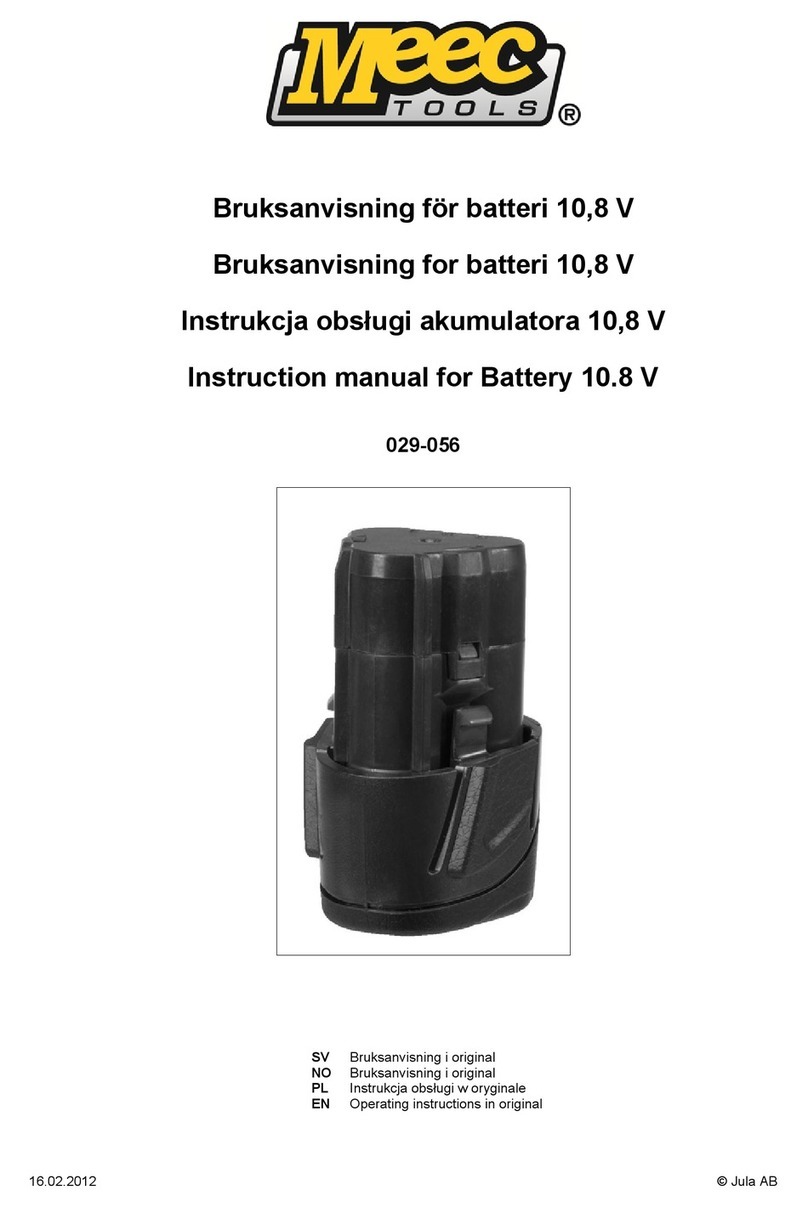
Meec tools
Meec tools 029-056 instruction manual

Aquatica Digital
Aquatica Digital Pro Digital 20062 operating manual
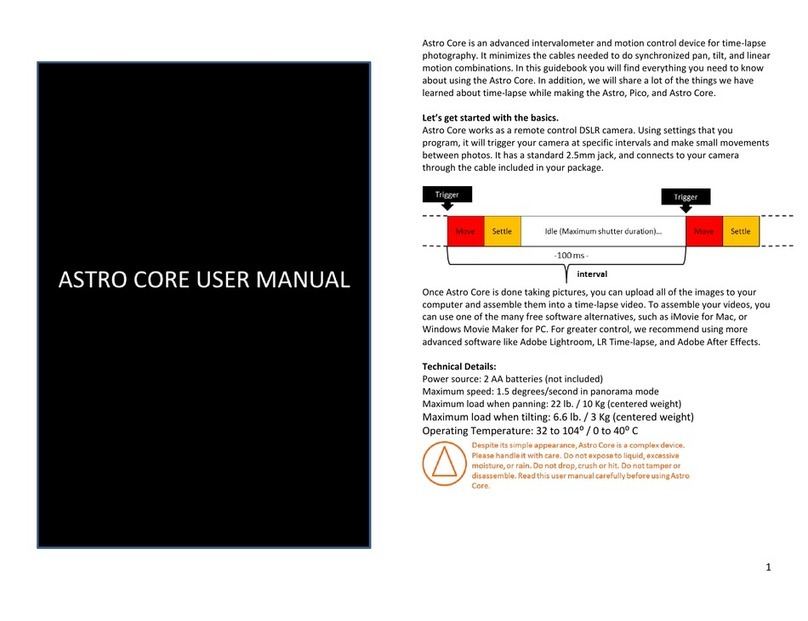
Electronic Technologies
Electronic Technologies Astro Core user manual
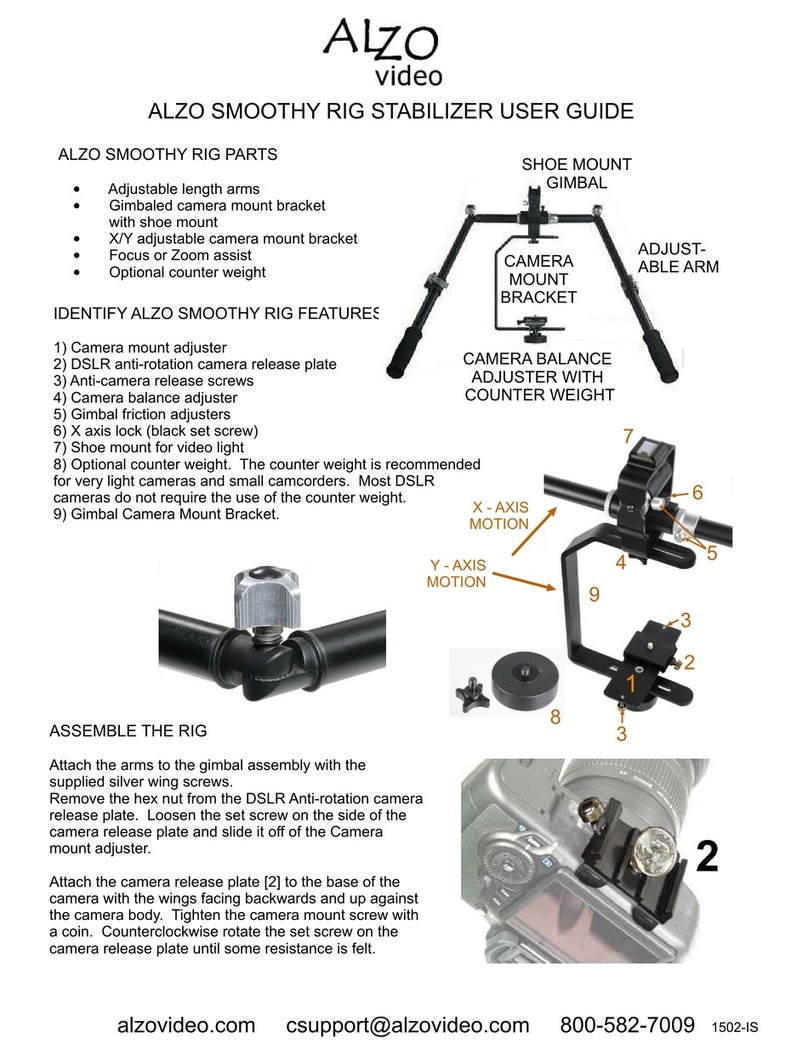
ALZO
ALZO SMOOTHY RIG user guide
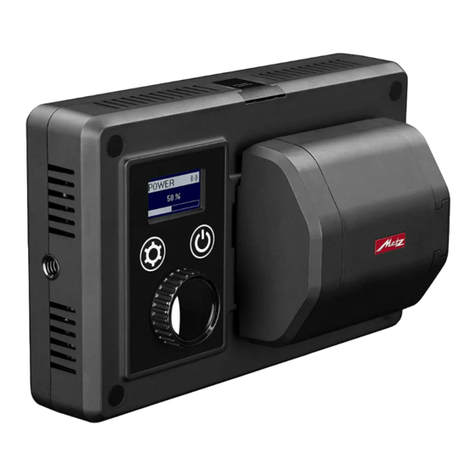
Metz
Metz mecalight L1000 BC instruction manual

Milwaukee
Milwaukee 48-11-1815 Operator's manual

